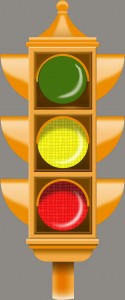 Traffic engineers in the United States have never agreed on how to time yellow lights so the interval between green and red is just right.
Traffic engineers in the United States have never agreed on how to time yellow lights so the interval between green and red is just right.
If it’s too short, drivers may run the red light by mistake. If it’s too long, they may intentionally risk driving through the intersection.
In the past, the Institute of Transportation Engineers (ITE) has tried to come up with a formula, but they couldn’t get enough support from their 15,000-plus members. That was 30 years ago, but they’re trying to create a standard again. Their findings might come before the board late this year at the earliest.
The current proposal relies on four factors: determining how long the yellow should last; vehicle approach speed; driver perception-reaction time; and the deceleration rate and grade of the road. Because no studies are available on these factors, the information they use will be approximations.
Timothy Gates, an engineering professor at Michigan State University and co-author of an ITE report, says it’s a matter of validating appropriate input values.
“If the formula suggests you need 4.5 seconds, and if you provide drivers with 3 seconds, you’re putting drivers into a case where they either have to stop abruptly or proceed through and run the risk of running the red light,” Gates reported recently in The Wall Street Journal.







































